
|
|
During the 12th cantury, the Ghaznavids were weakened considerably through their incessant warfare with the Seljuqs on their western frontier. The Ghorids were rulers of a
small kingdom in the Herat area, who took advantage of this weakness ... in 1151, their ruler Ala al-Din Husain, sacked Ghazna. Shortly thereafter, the Ghorids under Muhammad
bin Sam, annexed the remaining Ghaznavid territory in the Punjab. Then, in 1192, Muhammad bin Sam defeated Prithviraj Chauhan at Taraori, thereby extending his kingdom
almost to Delhi
Muhammad appointed Qutb ud-Din Aibak as his viceroy in northern India, and Aibak, in the same year, took Delhi from the Chauhans, making it his capital. When Muhammad
died in 1206, Aibak became independent of Ghorid overlordship. He himself died the following year, and was succeeded by his son Aram Shah. However, the nobles in Delhi did
not accept Aram Shah as their leader, electing instead Aibak's son-in-law and slave Iltutmish. Iltutmish defeated Aram Shah and thereby established the "Slave Dynasty" as the
rulers of the Delhi Sultanate.
|
 |
Muhammad bin Sam (1193-1206) |

|
Muhammad bin Sam (1193-1206), Gold dinar, Kanauj
Weight: 4.17 gm., Diameter: 21-22 mm., Die axis: 3 o'clock
Lakshmi seated facing /
3-line Nagari legend: sri maha / mad bini / sam |
 |
Muhammad bin Sam's gold coinage was modeled on the gold coins that were already in circulations, with a facing seated
Lakshmi and a reverse Nagari legend. This coin is thought to have been minted in Kanauj or Kashi. |
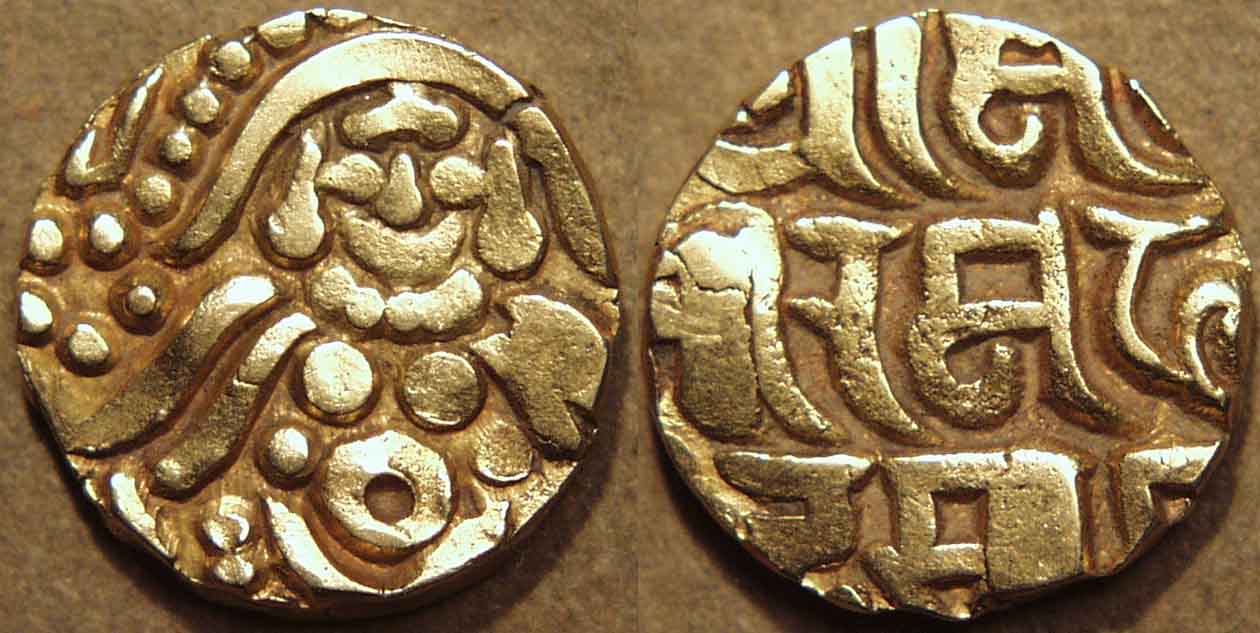
|
Muhammad bin Sam (1193-1206), Gold dinar, Bayana
Weight: 4.24 gm., Diameter: 15 mm., Die axis: 11 o'clock
Lakshmi seated facing /
3-line Nagari legend: srimad / hamira maha / mad sam |
 |
These smaller, dumpier coins, with a different legend, are thought to have been minted in Bayana. |
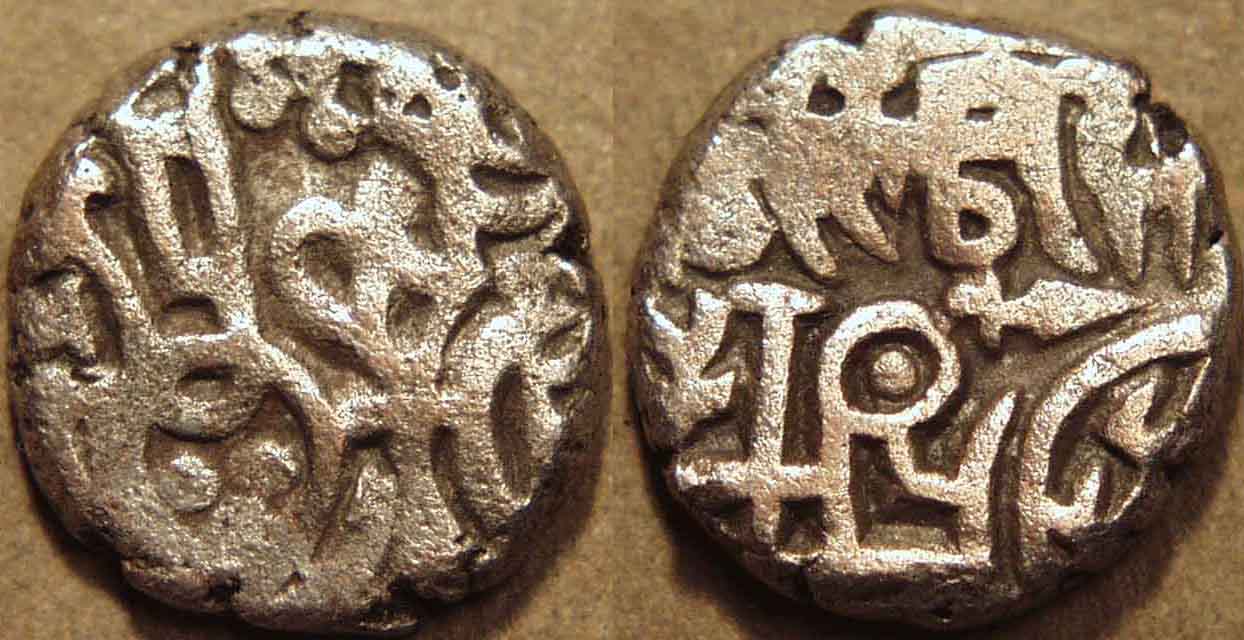
|
Muhammad bin Sam (1193-1206), Billon jital, Budaun
Weight: 3.29 gm., Diameter: 15 mm., Die axis: 5 o'clock
Stylized horseman right /
Stylized recumbent bull left, dagger above, Nagari legend over: sri mahamad sam |
 |
Muhammad's billon coins were modeled on the "bull and horseman" coins originated by the Shahis, but then adopted
also by the Rajputs and other dynasties. |

|
Muhammad bin Sam (1193-1206), Billon jital, Delhi
Weight: 3.44 gm., Diameter: 15 mm., Die axis: 4 o'clock
Stylized horseman right, Nagari legend around: sri hamirah /
Stylized recumbent bull left, Nagari legend around: sri mahamad sam |
 |
These jitals were called dehlival as a consequence of their source. |
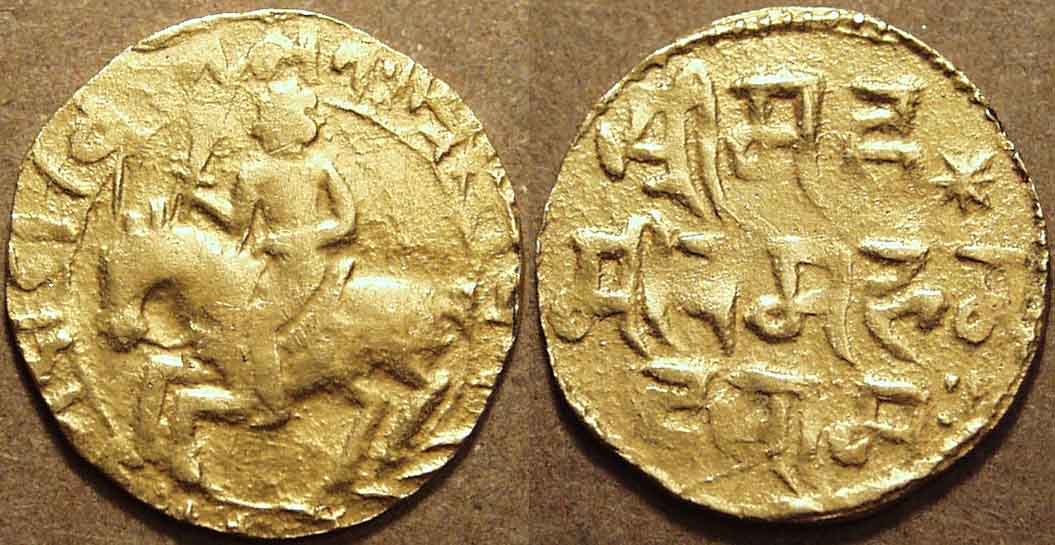
|
Muhammad bin Sam (1204-1206) Gold 20-ratti
Weight: 2.30 gm., Diameter: 17-18 mm., Die axis: 6 o'clock
Horseman galloping left, holding mace, Nagari legend around: samvat 1262 bhadrapada /
3-line Nagari legend: srima ha / mira mahama / da saamah,
Ref: GG B3, Raj 104 |
 |
One of the first Islamic coins struck in Bengal, this coin was struck by the Ghorid general Muhammad Bakhtiyar Khalji in
the name of his overlord, Muhammad bin Sam, in 1204, soon after his conquest of the province. |
 |
 |
 |
Shams al-Din Iltutmish (1210-1235) |
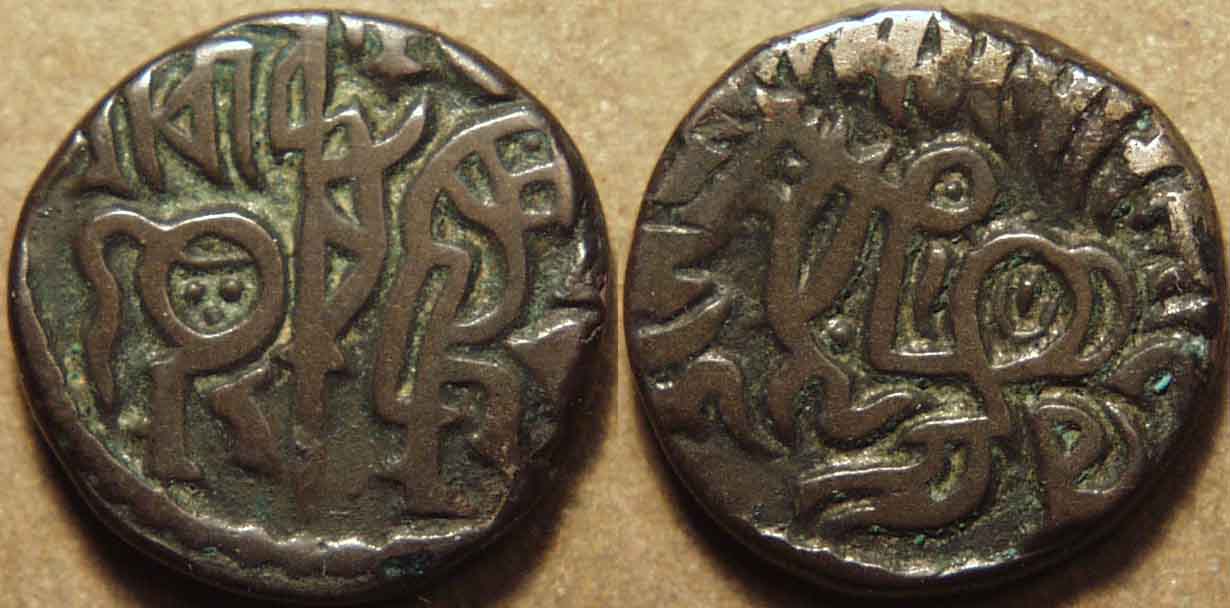
|
Shams al-Din Iltutmish (1210-1235), Billon jital, Delhi
Weight: 2.96 gm., Diameter: 15 mm., Die axis: 8 o'clock
Stylized horseman right, Nagari legend around: sri hamirah /
Stylized recumbent bull left, Nagari legend around: suritana sri samasadina |
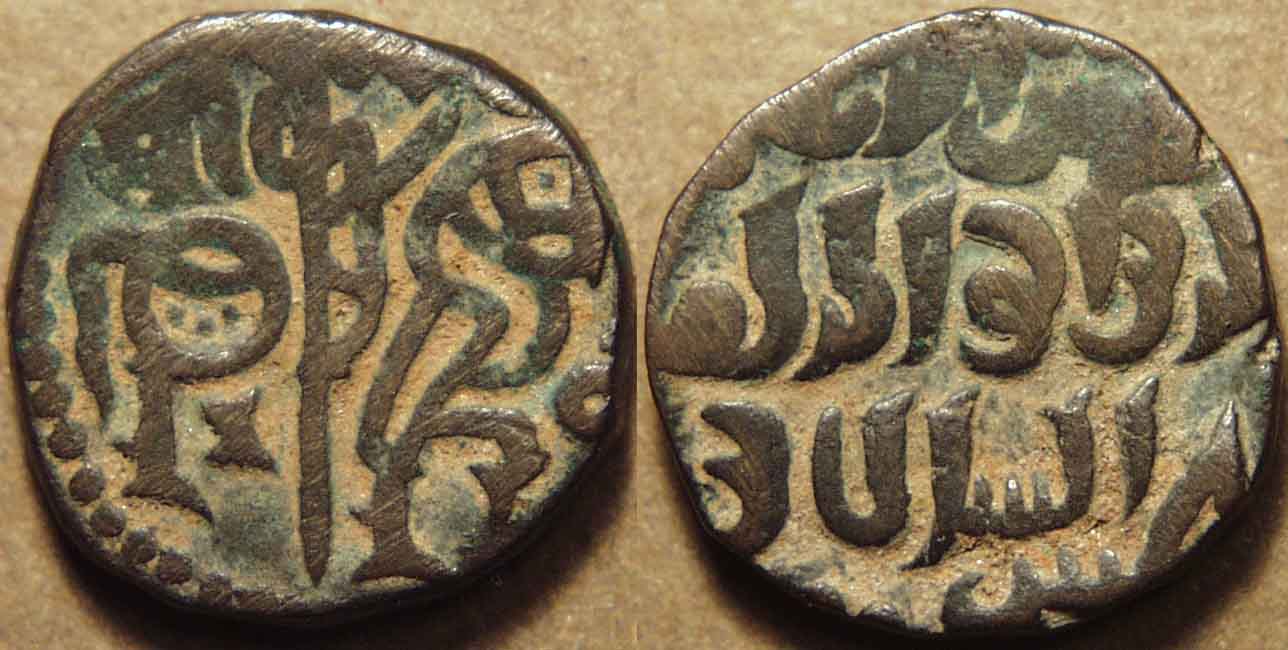
|
Shams al-Din Iltutmish (1210-1235), Billon jital, Lahore
Weight: 3.66 gm., Diameter: 15 mm., Die axis: 1 o'clock
Stylized horseman right, Nagari legend around: sri hamirah /
Four line Arabic legend: shams al-dunya wa'l din abu'l muzaffar iltutmish al-sultan |
 |
Iltutmish eliminated the bull on the reverse, replacing it with an Arabic legend. |
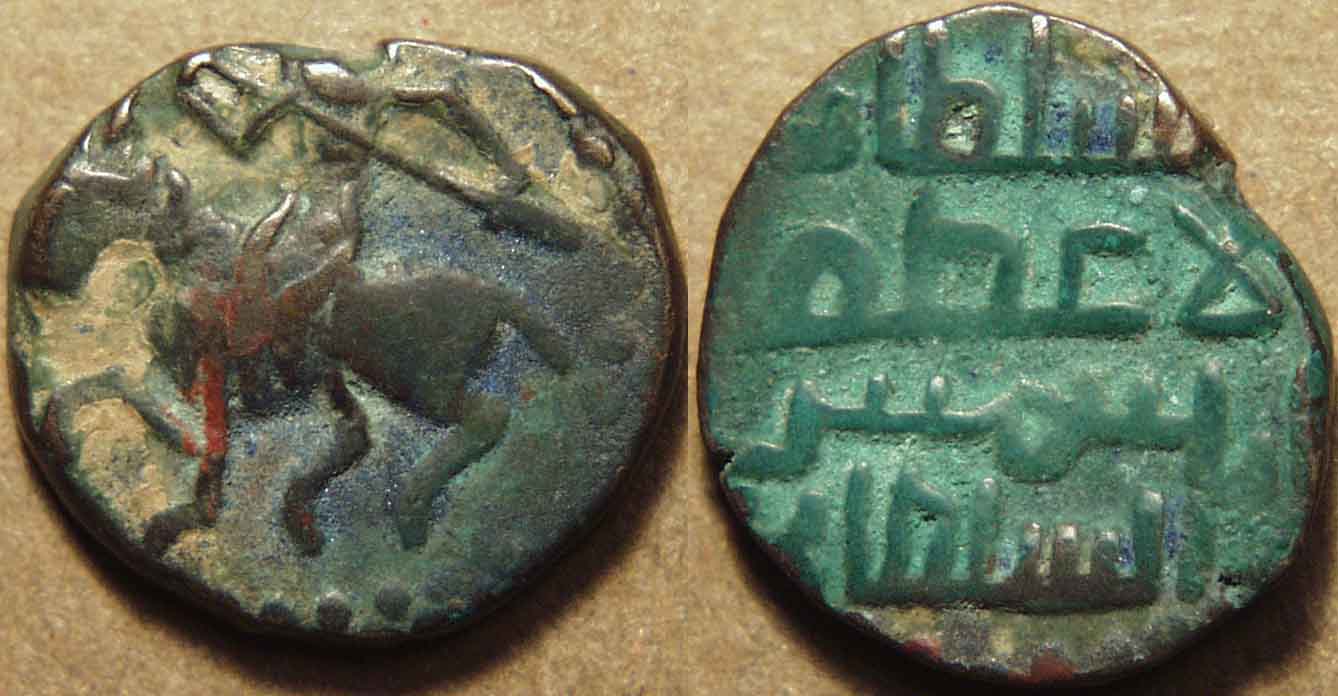
|
Shams al-Din Iltutmish (1210-1235), Billon jital, Lahore
Weight: 3.39 gm., Diameter: 15-16 mm., Die axis: 11 o'clock
Horseman left, holding lance /
Four line Arabic legend: al-sultan al-a'zam iltutmish al-sultan |

|
Shams al-Din Iltutmish (1210-1235), Copper "adli", Delhi
Weight: 3.27 gm., Diameter: 15 mm., Die axis: 4 o'clock
Arabic legend: 'adl /
Arabic legend: shams
Ref: GG D66, Raj --- |
 |
Goron and Goenka have only a line drawing of this type and indicate that coins are usually worn, so that their
announced weight of 2.9 gm. is probably too low. This coin, in excellent condition, and weighing 3.27 gm, proves their expectation and helps us establish a baseline
for the expected weight of the type. |
 |
 |
 |
Razia Sultana (1236-1240) |
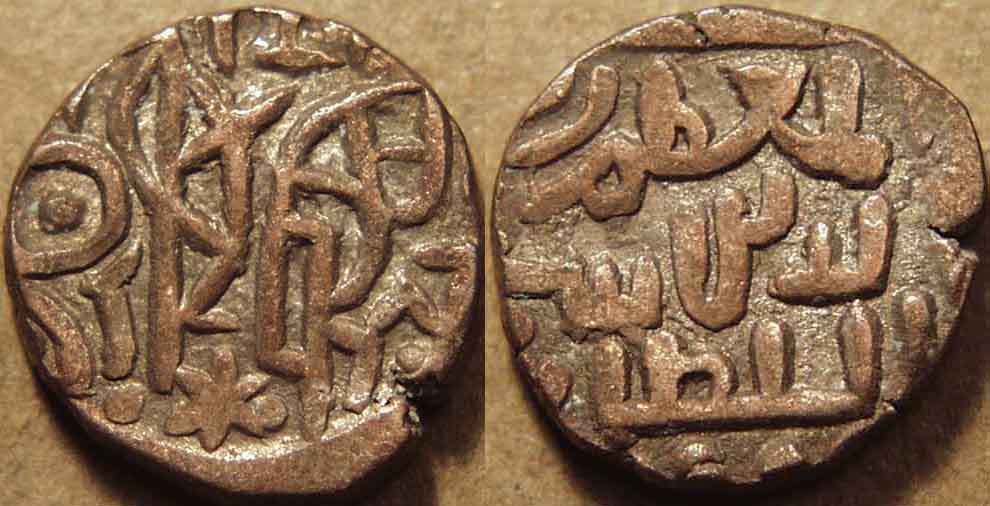
|
Jalalat al-Din Radiyya (1236-40), Billon jital, Delhi
Weight: 3.58 gm., Diameter: 15 mm., Die axis: o'clock
Stylized horseman right /
Four line Arabic legend: al-sultan al-mu'azzam radiyyat al-din bint al-sultan |
 |
Razia was the daughter of Iltutmish, who favored her succession because he felt his sons were not capable of rule. She
was a courageous and able ruler, but the nobles could not adjust to the idea of being ruled by a woman and eventually waged war against her and killed her. She is one of the
few female monarchs in Islamic history. |
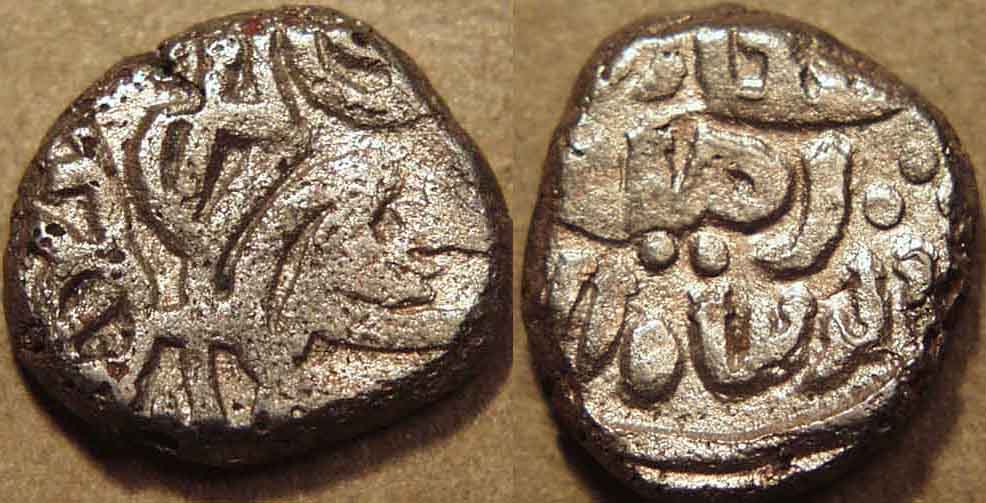
|
Jalalat al-Din Radiyya (1236-40), Billon jital, Delhi
Weight: 3.70 gm., Diameter: 14-16 mm., Die axis: 11 o'clock
Stylized horseman right /
Four line Arabic legend: al-sultan al-a'zam radiyyat al-dunya wa'al-din |
 |
Ala al-Din Masud (1242-1246) |
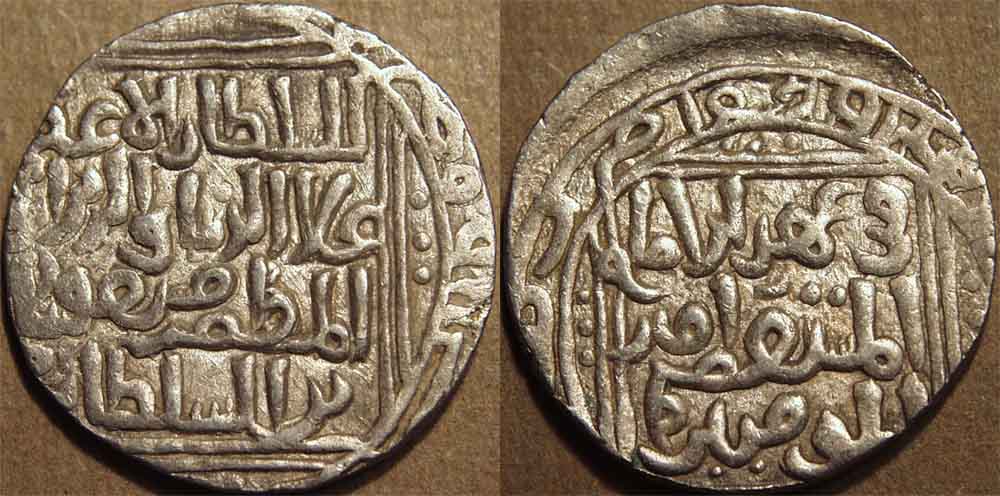
|
Ala al-Din Masud (1242-1246), Silver tanka, Hadrat Dehli
Weight: 11.02 gm., Diameter: 27 mm., Die axis: 1 o'clock
Legend with the name of the sultan and his titles /
Legend with the name of Caliph al-Must'asim |
 |
The tanka of approximately 11 gm. was a denomination introduced by Iltutmish, replacing the Arab dirham of around 5 gm.
Masud was the grandson of Iltutmish, son of Firuz Shah, who had ruled briefly at the behest of the Turkish nobles after the death of Iltutmish. He proved to be a weak and
ineffective ruler, and was deposed by the nobles in 1246. |
 |
 |
 |
Nasir al-Din Mahmud (1246-1266) |
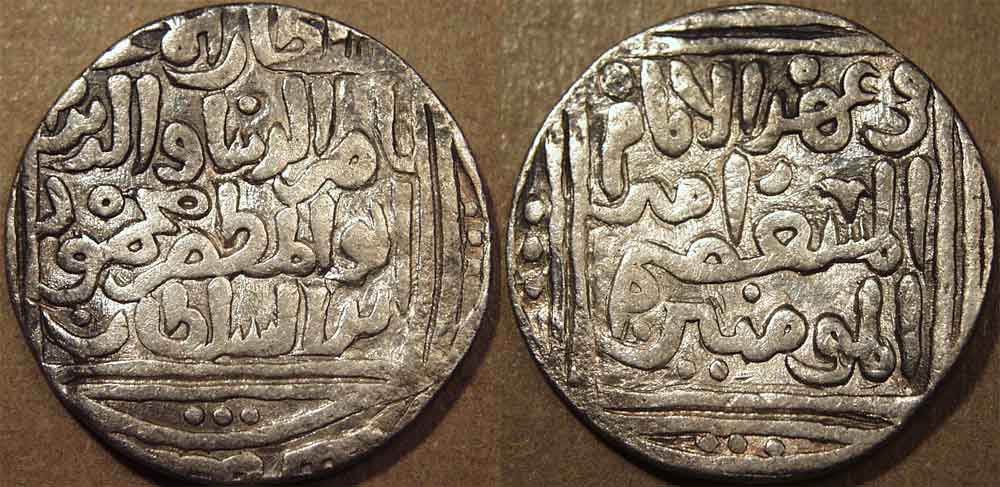
|
Nasir al-Din Mahmud (1246-1266), Silver tanka, Hadrat Dehli
Weight: 10.61 gm., Diameter: 28 mm., Die axis: 12 o'clock
Legend with the name of the sultan and his titles /
Legend with the name of Caliph al-Must'asim |
 |
Mahmud was the uncle of Masud, installed by the nobles in his stead. He attempted to restore the flagging fortunes of the
Sultanate, with mixed success. |
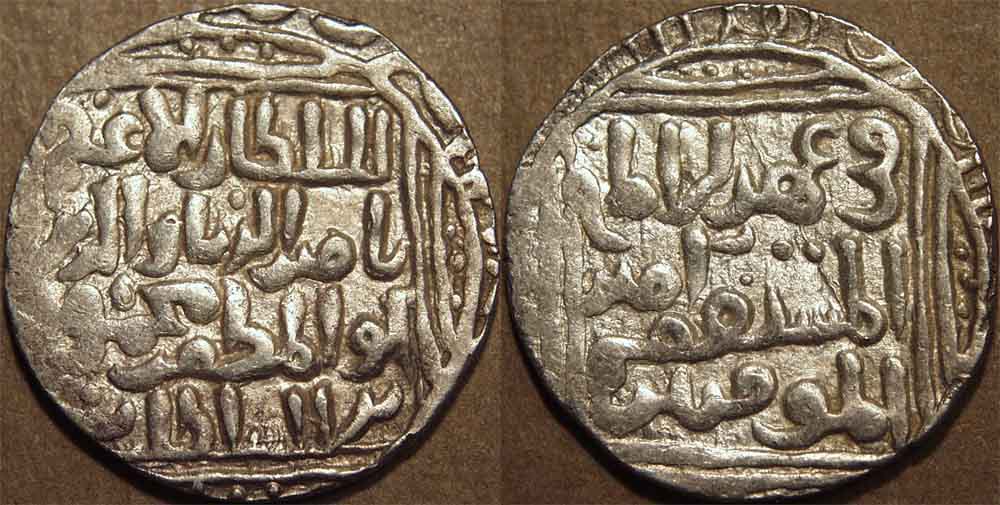
|
Nasir al-Din Mahmud (1246-1266), Silver tanka, Hadrat Dehli
Weight: 10.99 gm., Diameter: 28 mm., Die axis: 7 o'clock
Legend with the name of the sultan and his titles /
Legend with the name of Caliph al-Must'asim |

|
Nasir al-Din Mahmud (1246-1266), Silver tanka, Hadrat Dehli
Weight: 10.99 gm., Diameter: 28 mm., Die axis: 7 o'clock
Legend with the name of the sultan and his titles /
Legend with the name of Caliph al-Must'asim |
 |
Variety with both annulets and dots in the border segments.
|
 |
 |
 |
Ghiyath al-din Balban (1266-87) |
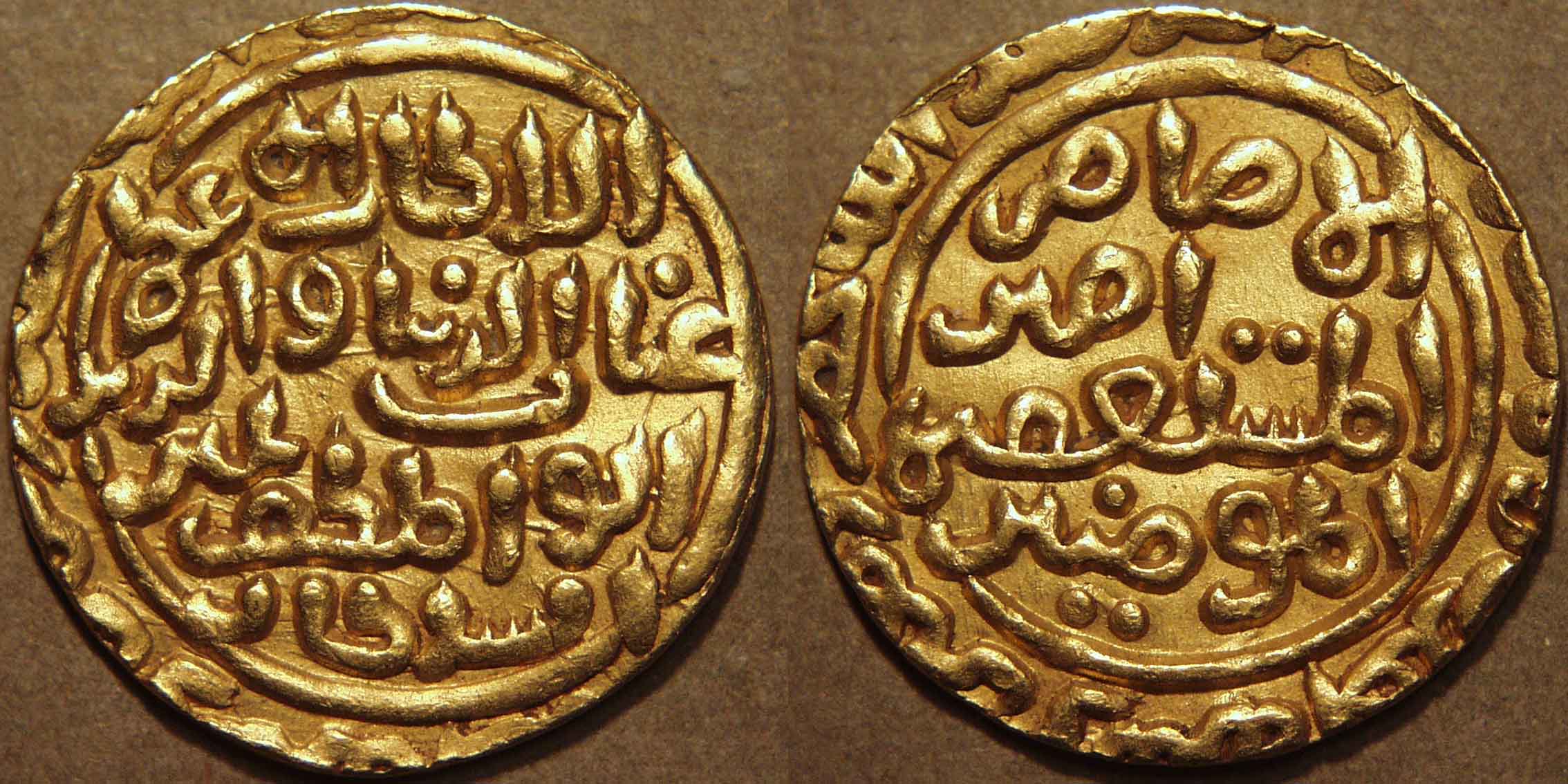
|
Ghiyath al-din Balban (1266-87), Gold tanka, Hadrat Dehli
Weight: 10.96 gm., Diameter: 27 mm., Die axis: 7 o'clock
Legend with the name of the sultan and his titles /
Legend with the name of Caliph al-Must'asim
in the margin, date AH 681 (=1282-83 CE) |
 |
Balban was Mahmud's Lord Chamberlain, and also his father-in-law. When Mahmud died, there was no male heir in the
house of Iltutmish, and Balban came to the throne. He proved to be an able ruler, who restored some order to the sultanate. |
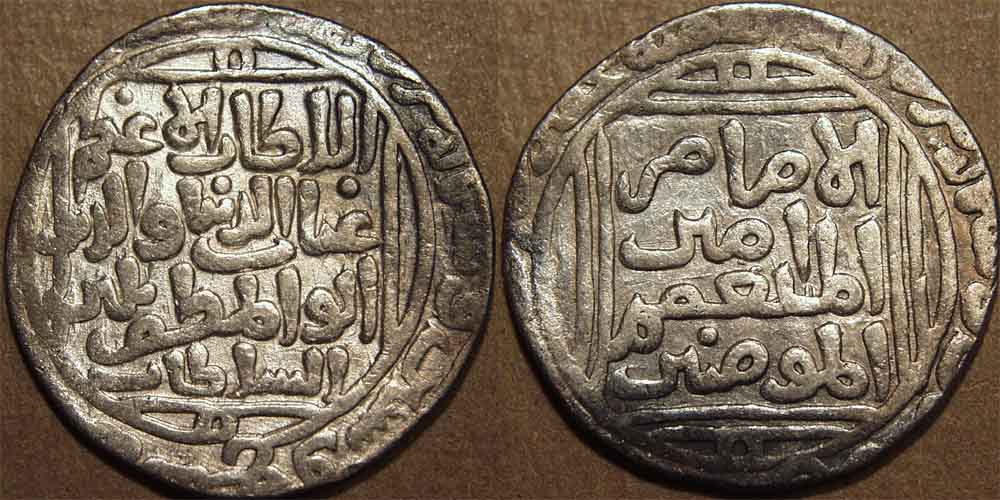
|
Ghiyath al-din Balban (1266-87), Silver tanka, Hadrat Dehli
Weight: 10.74 gm., Diameter: 30 mm., Die axis: 4 o'clock
Legend with the name of the sultan and his titles /
Legend with the name of Caliph al-Must'asim |
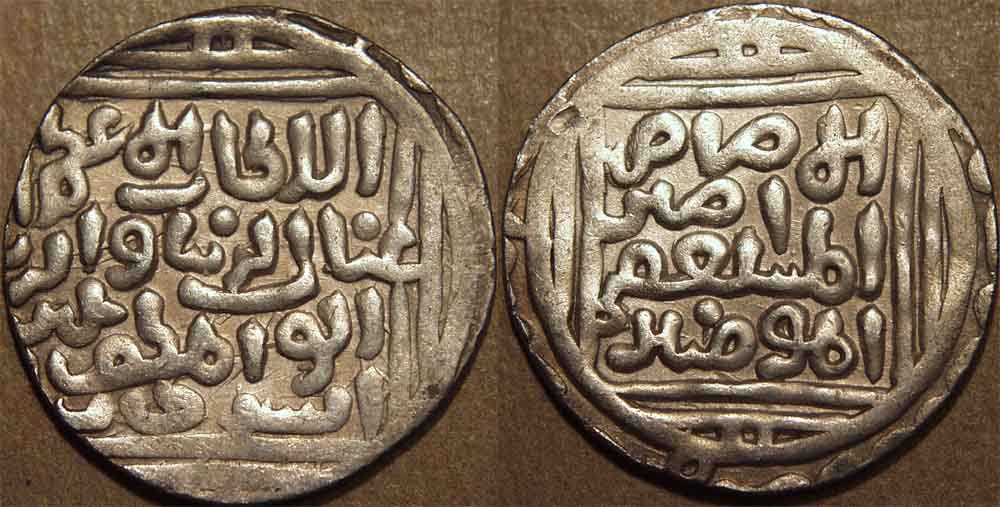
|
Ghiyath al-din Balban (1266-87), Silver tanka, Hadrat Dehli
Weight: 10.79 gm., Diameter: 30 mm., Die axis: 8 o'clock
Legend with the name of the sultan and his titles /
Legend with the name of Caliph al-Must'asim |
 |
This variety has a double square within the circular border on the obverse. The previous coin had a single square. |
 |
 |
 |
Mu'izz al-din Kaiqubad (1287-90) |

|
Mu'izz al-din Kaiqubad (1287-90), Silver tanka, Hadrat Dehli
Weight: 10.88 gm., Diameter: 30 mm., Die axis: 4 o'clock
Legend with the name of the sultan and his titles /
Legend with the name of Caliph al-Must'asim |
 |
Balban had wanted to be succeeded by his grandson, but the nobles installed instead Mu'izz al-din Kaiqubad. the 18-
year old son of the governor of Bengal. Kaiqubad turned out to be completely incompetent, spending his time in debauchery. The sultanate fell into disarry and the door was
opened wide for Jalal al-Din Firuz Khalji, the appointed commander of the army, to seize power. |
|
|